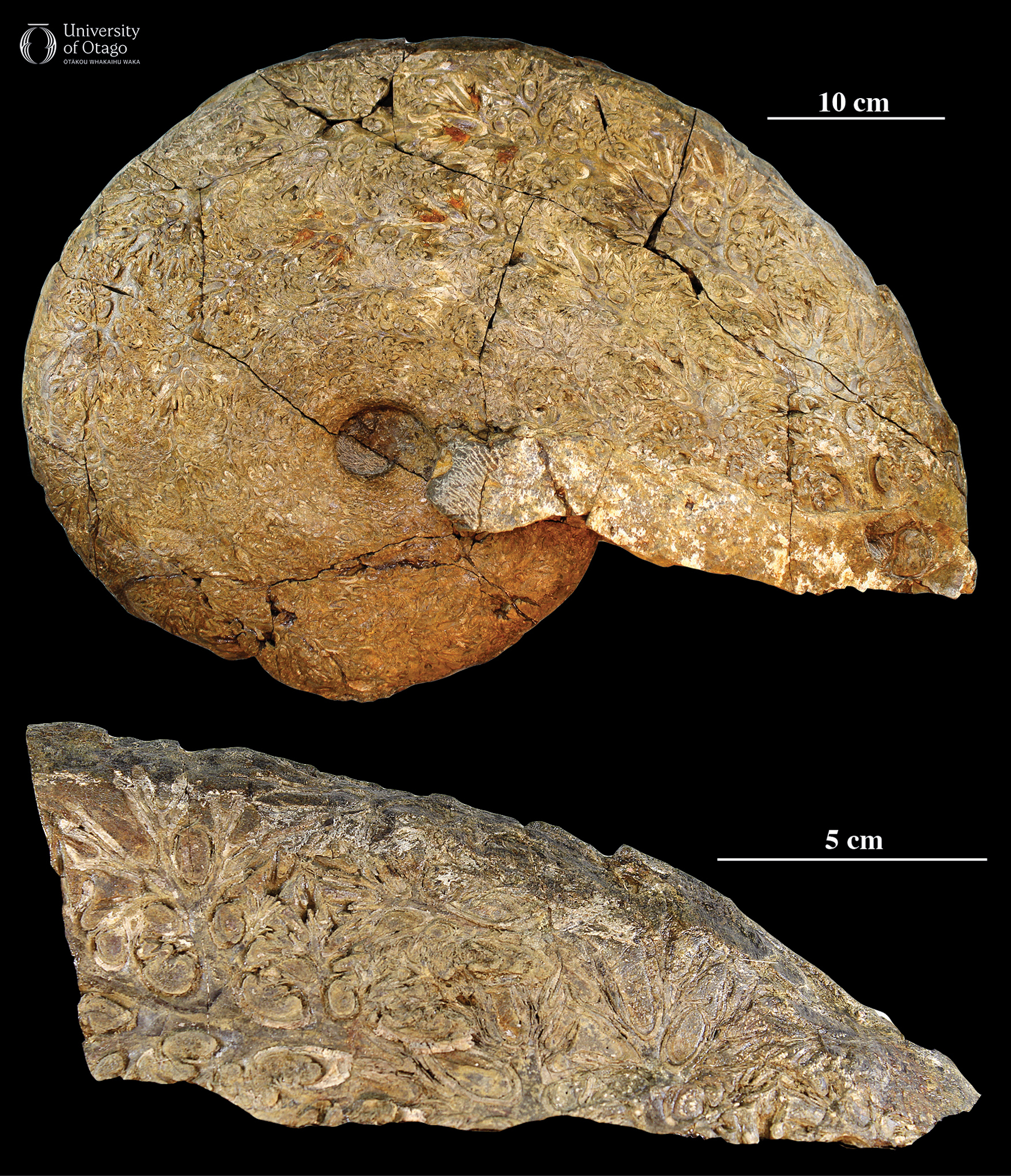36 Mystery ammonite from Papatowai needs a name
Mollusca, Cephalopoda: Phylloceratidae
The Geology Museum has hundreds of specimens of ammonites in addition to Kossmaticeras. Many of them are from rocks of Mesozoic age from the folded strata of the Southland Syncline (Murihiku Terrane), from the Hokonui Hills and from the Catlins area in South Otago.

Natural mould of the shell from an unidentified ammonoid (specimen OU 48255). The tree-like and round shapes across this fossil are the ornamentation left by the internal walls (i.e. sutures) that would have separated the internal chambers of the shell during life. Image credit: JH Robinson. |
The largest ammonite specimen on display in the Geology Museum is labelled “Zetoceras”. However, the identity of this fossil is uncertain as it has not yet been studied in detail. About 50 cm by 30 cm across (bigger than a large dinner plate), this handsome, laterally flattened ammonite is distinguished by complex suture lines which are only visible because the otherwise smooth exterior of the shell has been eroded away. It probably belongs in the family Phylloceratidae, a group of ammonites characterised by very complex sutures. These mobile carnivores would have possessed excellent vision, roaming the seas around what is now South Otago to feast on small fish, possibly crustaceans or other molluscs.
 |
Did you know there is a 3D printable model of this fossil for you to view online and download? Follow this link to learn more: 3D model—Mystery ammonite from Papatowai needs a name. |
Mesozoic fossils discovered in the North and South islands of Aotearoa have a special connection, which ammonite discoveries help to reveal. The first ammonites reported from Aotearoa were discovered by Ferdinand von Hochstetter in 1859, and these come from the Kawhia Harbour region of the west coast of the North Island. The fossil record for ammonites from Aotearoa would soon be joined by new discoveries from the Hokonui Hills in Southland, which were described by Patrick Marshall in 1909. Marshall compared the fossils from both locations and supported an earlier idea from Sir James Hector that the faunas of both locations belonged to the same “…conformable series of rocks as of an age extending from Permian to Jurassic…” Today, we know this to be the case, as the same Murihiku Terrane that crops out in Papatowai and elsewhere in Southland can be discovered forming beach platforms and cliffs at Kawhia. And at each location, it is possible to discover Phylloceratidae ammonites.
Like many other specimens on display in the Geology Museum, this specimen was collected and prepared by the late Andrew Grebneff who was passionately interested in molluscs of all kinds, both living and fossil.
—Written by Daphne E Lee and Daniel B Thomas
| Specimen number: OU 48255 | Age: Approximately 190 million years old (early Jurassic) |
| Locality: Picnic Point, Papatowai, South Otago | Rock Formation: Otekura Formation |
| Collected by: Andrew Grebneff and others | |
| Citation: Specimen not yet described. | |
251.9 to 66 million years ago. The Mesozoic Era is the section of geological history spanning the Triassic, Jurassic and Cretaceous periods.
Layers of rock that stack up on top of one other over time. A single layer is a stratum. The different layers can appear in different colours or have other properties that differentiate them when they form under different conditions. For example, a stratum that is mostly made up of sand-sized sedimentary grains might be stacked up on top of a layer that is mostly made up of mud-sized sedimentary grains. Strata are important for understanding geological history and environmental change.
A section of Earth's crust that has a geological history that is distinct from the geological history of the section of crust in the surrounding areas. For example, the Murihiku Terrane is a major geological feature in Aotearoa New Zealand, especially prominent in the Southland and western North Island regions.
A join between structures. Examples of sutures include the join between a septum and the shell wall in a nautiloid, or between two bones in a vertebrate.
The animals of a particular geographic region (e.g. the fauna of New Zealand), environment (e.g. the marine fauna) or geological period (e.g. the Oligocene fauna).
298.9 to 251.9 million years ago.
201.4 to 143.1 million years ago.

